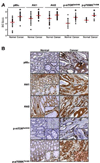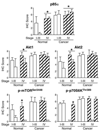Novel expression patterns of PI3K/Akt/mTOR signaling pathway components in colorectal cancer
- PMID: 20421047
- PMCID: PMC2895913
- DOI: 10.1016/j.jamcollsurg.2009.12.008
Novel expression patterns of PI3K/Akt/mTOR signaling pathway components in colorectal cancer
Abstract
Background: The phosphatidylinositol 3-kinase/Akt/mammalian target of rapamycin (PI3K/Akt/mTOR) pathway plays a critical role in the growth and progression of colorectal cancer (CRC). The purpose of our study was 2-fold: (1) to determine the expression levels of several key components of this pathway, including p85alpha, Akt1, Akt2, p-mTOR(Ser2448), and p-p70S6K(Thr389) in CRCs; and (2) to correlate the expression of these proteins with cancer stage and location (left versus right side).
Study design: Immunohistochemistry for p85alpha, Akt1, Akt2, p-mTOR(Ser2448), and p-p70S6K(Thr389) was performed on normal colon and CRCs from 154 patients.
Results: All proteins investigated were significantly overexpressed in CRCs compared with matched normal colonic tissue from the same patient (p < 0.0001). PI3K pathway component proteins were moderately correlated across normal and malignant colon tissues; correlations tended to be stronger in normal tissues as compared with the same correlations in cancers. Expression levels of p85alpha were significantly higher in stage IV cancers than in stage I to III cancers (p = 0.0005). p85alpha expression was also significantly increased in the adjacent normal colonic mucosa of patients with stage IV CRC compared with earlier stages (p = 0.003). Finally, expression of Akt1, Akt2, and p-p70S6K(Thr389) was higher in left-sided CRCs compared with CRCs in the right colon (p = 0.007, p = 0.0008, and p = 0.04, respectively).
Conclusions: The PI3K/Akt/mTOR pathway components, p85alpha, Akt1, Akt2, p-mTOR(Ser2448), and p-p70S6K(Thr389) are highly overexpressed in CRCs, providing the rationale for targeting this pathway therapeutically in CRC patients. The increased expression of p85alpha in the adjacent normal mucosa of stage IV patients suggests an important field defect, which may contribute to the growth and progression of these cancers.
Copyright 2010 American College of Surgeons. Published by Elsevier Inc. All rights reserved.
Figures



References
-
- Jemal A, Siegel R, Ward E, et al. Cancer statistics, 2009. CA Cancer J Clin. 2009;59:225–249. - PubMed
-
- Griffin MR, Bergstralh EJ, Coffey RJ, et al. Predictors of survival after curative resection of carcinoma of the colon and rectum. Cancer. 1987;60:2318–2324. - PubMed
-
- Cantley LC. The phosphoinositide 3-kinase pathway. Science. 2002;296:1655–1657. - PubMed
-
- Philp AJ, Campbell IG, Leet C, et al. The phosphatidylinositol 3'-kinase p85α gene is an oncogene in human ovarian and colon tumors. Cancer Res. 2001;61:7426–7429. - PubMed
MeSH terms
Substances
Grants and funding
LinkOut - more resources
Full Text Sources
Miscellaneous

